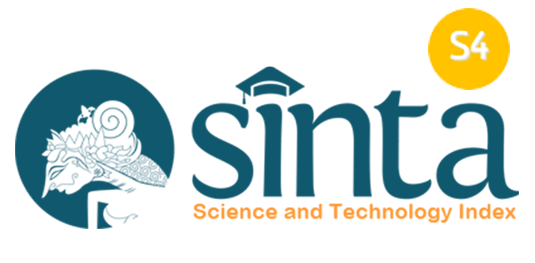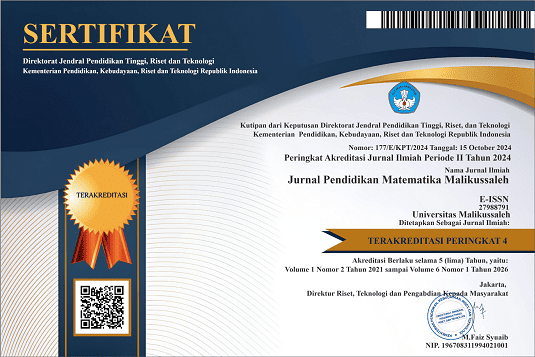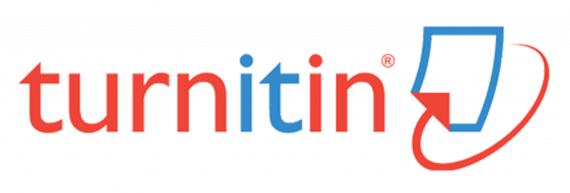PENGARUH MODEL PEMBELAJARAN THINK PAIR SHARE BERBANTUAN SOFTWARE WINGEOM TERHADAP KEMAMPUAN PENALARAN MATEMATIS PESERTA DIDIK
Abstract
Keywords
Full Text:
PDFReferences
Anggraini, A. K., Isharyadi, R., & Annajmi. (2020). Pengaruh Model Pembelajaran Kooperatf Tipe Thik Pair share (TPS) Terhadap Kemampuan Penalaran Matematis Siswa. Jurnal Pendidikan IIdonesia, 1(1), 1–8. https://doi.org/https://doi.org/10.61291/jpi.v1i1.2
Antafani, H. D., & Purwanti, K. Y. (2021). Efektivitas Model Pembelajaran Think Pair Share Berbantuan Media VBSC untuk Meningkatkan Kemampuan Penalaran Siswa. Jurnal Pendidikan MI/SD, 1(2), 149–162. https://doi.org/10.35878/guru/v1.i2.299
Asoraya, M. S., & Ruli, R. M. (2023). Analisis Kemampuan Penalaran Matematis Siswa SMP pada Materi Relasi dan Fungsi. Jurnal Cendikia: Jurnal Pendidikan Matematika, 07(November), 3053–3066. https://doi.org/10.31004/cendekia.v7i3.2412
Elisyah, N., Zahra, A., & Astuti, W. (2023). Pembelajaran Segitiga dan Segiempat Berbasis Pendidikan Matematika Ralistik Indonesia (PMRI) dengan Konteks Kertas Origami. Jurnal Cendekia : Jurnal Pendidikan Matematika, 7(2), 1039–1049. https://doi.org/10.31004/cendekia.v7i2.2247
Fonna, M., & Mursalin. (2018). Pengembangan Modul Geometri Analitik Bidang Berbantuan Wingeom Software untuk Meningkatkan Kemampuan Representasi Matematis Mahasiswa Program Studi Pendidikan Matematika Universitas Malikussaleh. Jurnal Pendidikan Matematika, 6(3)(1). https://doi.org/10.30738/union.v6i3.2988
Gustiadi, A., Agustyaningrum, N., Hanggara, Y., & Kepulauan, U. R. (2021). Analisis kemampuan penalaran matematis siswa dalam menyelesaikan soal materi dimensi tiga. Jurnal Pendidikan Matematika Dan Matematika, 4(1), 337–348. https://doi.org/https://doi.org/10.30606/absis.v4i1.894
Lahamu, S., Abdullah, I. H., & Suratno, J. (2023). Penerapan Model Pembelajaran Think Pair Share Untuk Meningkatkan Kemampuan Penalaran Matematis Siswa. Jurnal Pendidikan Guru Matematika, 3(3), 257–269. https://doi.org/10.33387/jpgm.v3i3.6627
Lestari, K. E., & Yudhanegara, M. R. (2015). Penelitian pendiidkan Matematika.
Miatun, A., & Ulfah, S. (2023). Kemampuan Penalaran Matematis Mahasiswa Calon Guru Matematika. Jurnal Teori Dan Riset Matematika, 8(2), 281–294. https://doi.org/https://dx.doi.org/10.25157/teorema.v8i2.1 1581
Pradana, O. R. Y. (2021). Pengaruh Model Pembelajaran Kooperatif Think Pair pada prestasi matematika siswa sekolah menengah pertama. Jurnal Jendela Pendidikan, 1(1), 1–6. https://doi.org/https://doi.org/10.57008/jjp.v1i1.1
Putri, D. K., Sulianto, J., & Azizah, M. (2019). Kemampuan Pelaralan Matematis Ditinjau dari Kemampuan Pemecahan Masalah. International Journal Of Elementary Education, 3(3), 6–11. https://doi.org/https://doi.org/10.23887/ijee.v3i3.19497
Sari, N. H., Sesunan, F., & Nyeneng, I. D. P. (2020). Pengaruh Penerapan Teori Van Hiele Berbantuan Software Wingeom Terhadap Kemampuan Penalaran Matematika Siswa Pada Materi Geometri. Information Technology Engineering Journals, 2(1). https://doi.org/https://doi.org/10.24235/itej.v2i1.13
Sugiyono. (2019). Metode Penelitian Pendidikan Pendekatan Kuantitatif, Kuaitatif, dan R&D.
Zahwa, N., Nurrosyadah, N., Maharani, D., Putri, R. ilma I., Nuraeni, Z., & Simarmata, R. H. (2019). Kemampuan Penalaran Matematis Siswa Dalam Menyelesaikan Soal Tipe TIMSS Konten Data, Bilangan Dan Pengukuran. Jurnal Ilmiah Pendidikan Matematika, 11(2), 117–128. https://doi.org/10.31941/delta.v11i2.1700
DOI: https://doi.org/10.29103/jpmm.v5i1.19604
 Article Metrics
Article Metrics
 Abstract Views : 32 times
Abstract Views : 32 times
Refbacks
- There are currently no refbacks.
Copyright (c) 2025 Mufidah - Alawiyah, Mufidah Alawiyah, Fajriana Fajriana, Nur Elisyah

This work is licensed under a Creative Commons Attribution-ShareAlike 4.0 International License.

This work is licensed under a Creative Commons Attribution-ShareAlike 4.0 International License. View My Stats






1.png)

